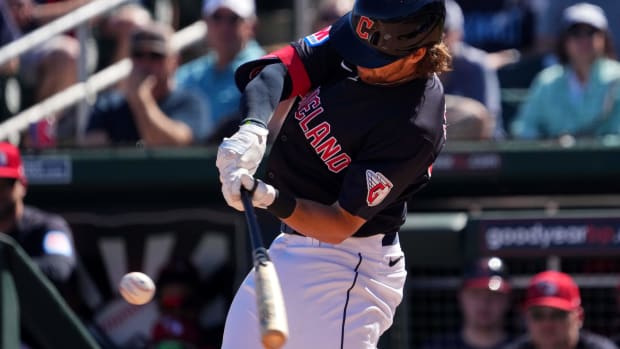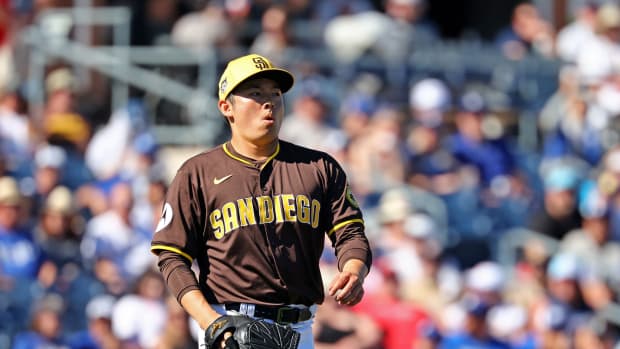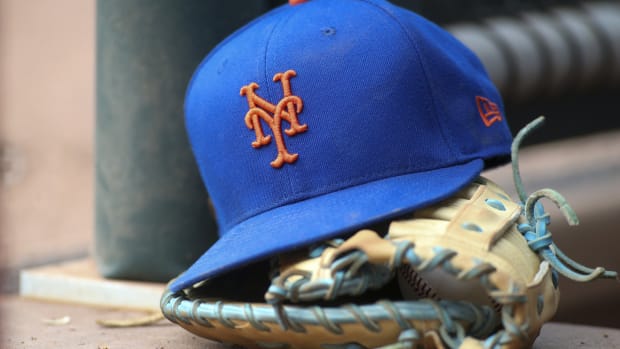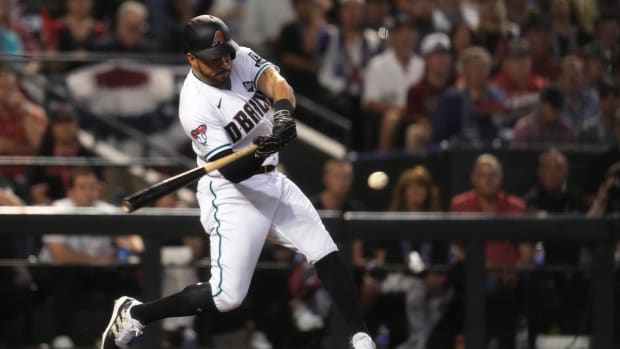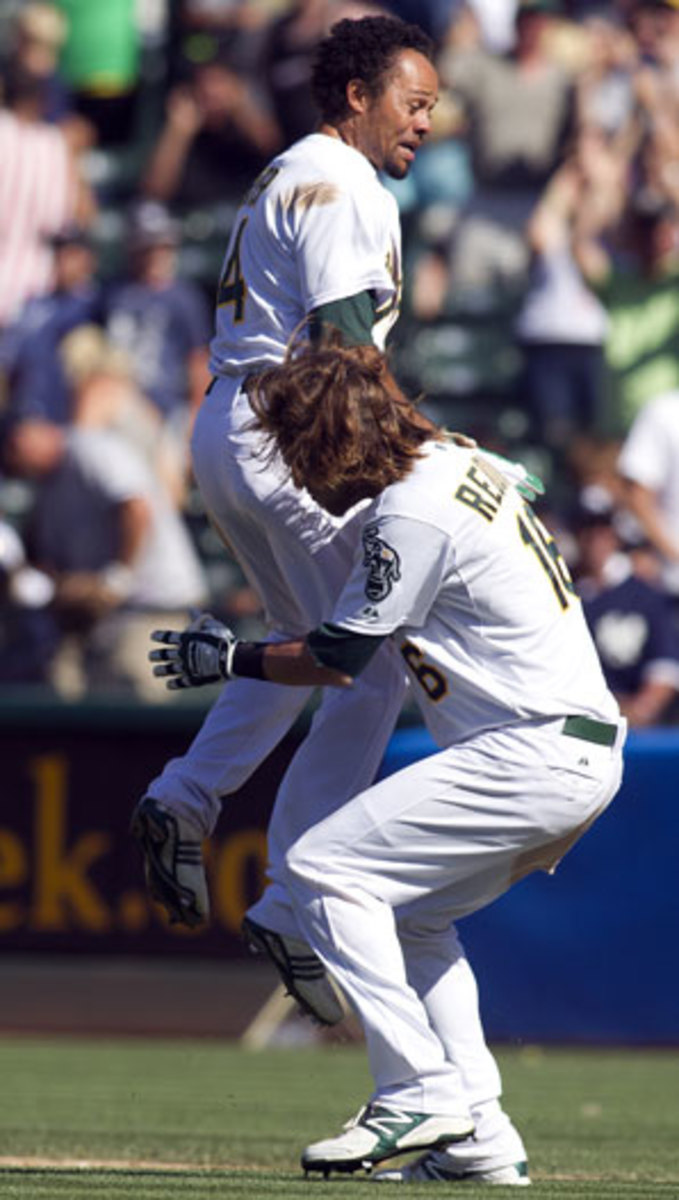
Revenge of Moneyball: How the A's are once again in the playoff hunt
Coco Crisp delivered a walk-off hit on Sunday, earning himself a lift from Josh Reddick and Oakland a sweep of the Yankees. (ZUMApress.com)
Fueled by the addition of a second Wild Card team in each league, this season has been full of unexpected playoff contenders. The Orioles are competing for their first postseason spot, and first winning season, since 1997, the Pirates for their first spot and first winning season since 1992. The Nationals, who own the NL's best record, are bidding for their first playoff berth since moving to Washington in 2005; the franchise hasn't made the playoffs since 1981, when it was still the Montreal Expos.
Now the A's are crashing the party. They haven't been out of the playoffs for nearly so long as the aforementioned teams — their last appearance was in 2006 — but with five straight finishes of .500 or below in a division where the Rangers and Angels are awash in newfound television revenue, few observers took Oakland for contenders at the outset of the season. Indeed, it's been long enough since the A's were in the playoff picture that their critics have derisively hailed "the death of Moneyball," referring to the polarizing 2003 Michael Lewis best-seller detailing the unconventional and often statistically-driven means by which general manager Billy Beane attempted to compete against wealthier teams while on a shoestring budget. Reports of that death, it would appear, have been greatly exaggerated.
Having just completed a four-game sweep of the Yankees at home — the first time they've swept the Bronx Bombers in four games since 1972, and the first time they've done so at home since 1913, when they were based in Philadelphia — the A's are now 51-44, tied with the Orioles for the second AL Wild Card berth, and just half a game behind the Angels, who hold the first. Since the beginning of July, they're 14-2, and dating back to June 10, they're 25-9, both major league bests; they've gone from nine games below .500 on the latter date to seven games over. Two of the four games against the Yankees, including Sunday, ended in walk-off fashion, and Oakland now leads the majors with 11 such wins.
At first glance, it's difficult to find many heroes in their offense, or to square their current cast with the patient and powerful A's teams that reached the playoffs five times in a seven-year span from 2000-2006. This year's A's rank last in the league in scoring at 3.81 runs per game, last in batting average (.228), second-to-last in on-base percentage (.302) and third-to-last in slugging percentage (.377). Some of that owes to the Oakland Coliseum, which is depressing scoring by about four percent this year, but even so, the team's True Average (runs per plate appearance, expressed on a batting average scale after adjusting for park and league scoring environments) is .253, 12th in the league, and seven points below the major league average.
Yet the top A's hitters do reflect a link to Beane's Moneyballing ways, which were always about more than just emphasizing on-base percentage. They represent the unconventional routes by which the team has acquired players given the difficulty of matching wealthier clubs with draft or international signing bonus money, or luring them to a decrepit ballpark that the team is trying desperately to replace, even if that means relocating (an effort that has effectively been filibustered by commissioner Bud Selig and the Giants, who own the territorial rights to San Jose). Consider:
* Top slugger Yoenis Cespedes, whose .336 True Average ranks fifth in the league, is a Cuban defector whom the A's signed to a four-year, $36 million deal, a daring gambit given his lack of a track record stateside, but a fairly small expenditure relative to the free agent market.
* Rightfielder Josh Reddick, whose 21 homers lead the team, is 14th in the league with a .313 True Average; he was acquired from the Red Sox this past winter in a trade that sent closer Andrew Bailey and outfielder Ryan Sweeney to Boston, one of several deals over the years in which Beane has developed and traded a proven closer for more critical parts.
* Leftfielder/designated hitter Seth Smith, who's 27th with a .299 True Average, was acquired from the Rockies in an exchange for Josh Outman and Guillermo Moscoso, two flyball-oriented pitchers whose approaches were far better suited for the Coliseum, with its spacious foul territory, than for Coors Field, where balls in the air are a hazard; in limited duty for Colorado, the duo have ERAs of 9.00 and 8.23, respectively.
* DH Jonny Gomes, whose 191 plate appearances aren't enough to qualify for the batting title, is a platoon-oriented journeyman who has put up a .321 True Average for the measly salary of $1 million.
* First baseman Brandon Moss is a scrap-heap pickup who has belted a career-high 11 homers in 120 plate appearances after hitting just 15 in 749 PA from 2007-2011, spread out over three organizations.
The offense has its share of sinkholes, too; in my latest Replacement-Level Killers feature at Baseball Prospectus, I identified three positions where the team's production ranked either the worst or second-worst among contenders, namely at catcher (where Kurt Suzuki and others have hit a combined .193/.245/.255, with Suzuki's first homer of the season coming on Sunday), third base (where Brandon Inge and others have hit .184/.230/.333) and shortstop (where Cliff Pennington and friends have hit .184/.244/.273).
All of which points to their pitching staff as a critical piece of their success — and again, a reflection of Beane's resourcefulness. The A's have held their opponents to a league-low 3.63 runs per game with a rotation that features four pitchers with ERAs of 3.34 or lower: Brandon McCarthy (2.54), Travis Blackley (2.86), Jarrod Parker (3.00) and Tommy Milone (3.34), with Bartolo Colon (3.97) bringing up the rear. McCarthy is a reclamation project, a former top prospect for the White Sox and Rangers whose history of scapular stress fractures — an injury rare in the MLB annals — landed him on the scrap heap prior to last season. Once a flyball-oriented pitcher, he has studied sabermetrics to remake himself as a groundballer — lessening the stress on his shoulder in the process — and has allowed just 0.6 homers per nine in a season and a half with Oakland. Blackley is an Australian who has toiled for seven different organizations; he was acquired off waivers from the Giants in mid-May. Parker is a former blue-chip prospect who was a key piece in the trade that sent Trevor Cahill to Arizona, while Milone was part of the four-player return that came from the Nationals in exchange for Gio Gonzalez; both are out of Beane's grand tradition of dealing top-flight starters once they got too expensive for Oakland's payroll. Colon, meanwhile, is a 39-year-old former Cy Young winner who resurrected his career last season with the Yankees after undergoing a groundbreaking medical procedure; he's making all of $2 million. Closer Ryan Cook is a rookie acquired in the Cahill trade; he didn't notch his first major league until June 12, but his microscopic ERA (now 1.70 after a couple dings by the Yankees) led him to be selected for the All-Star team.
Grant Balfour
voila!































